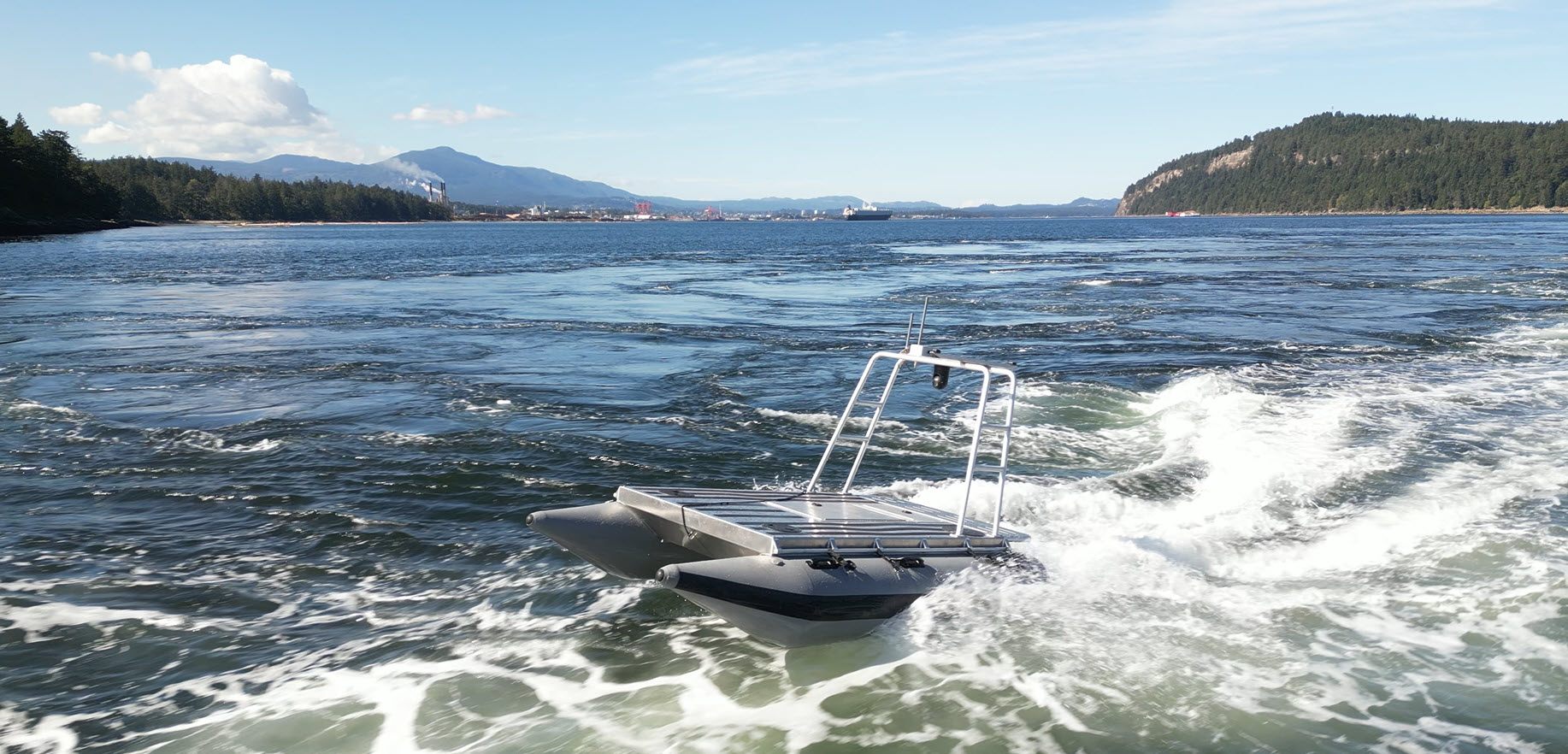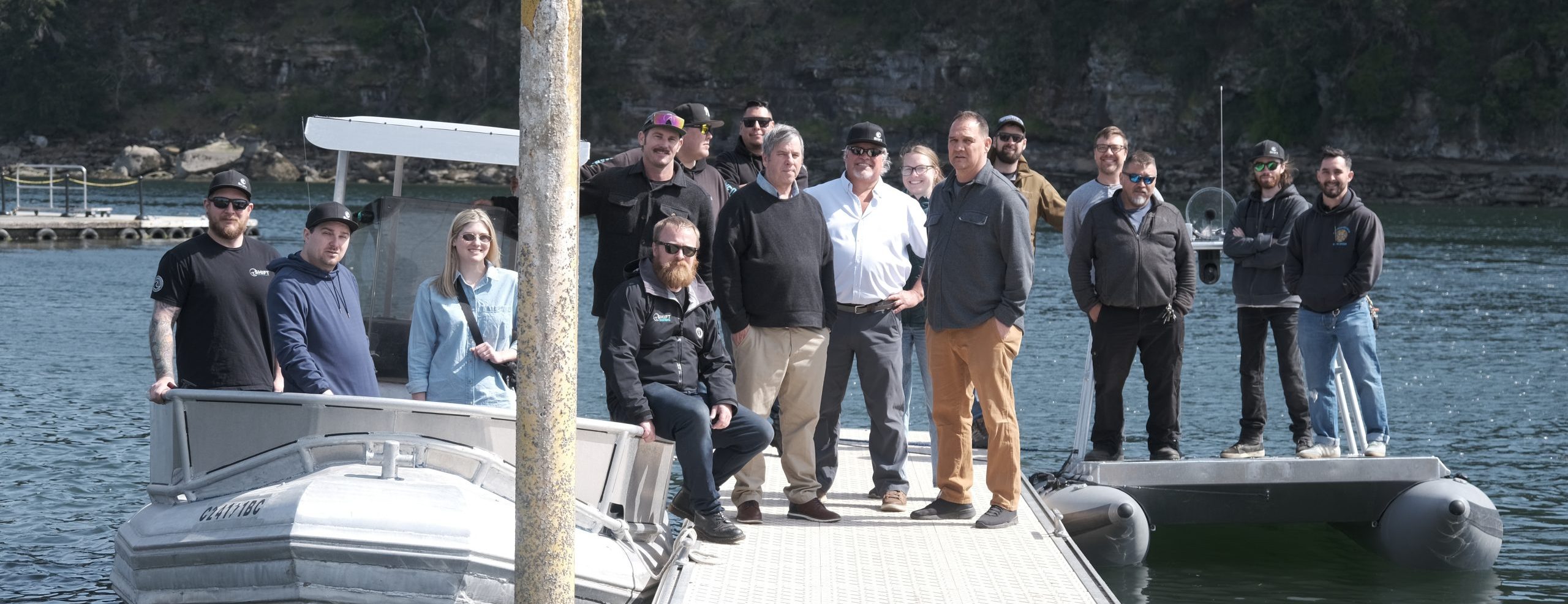
On a spring morning in 2017, James Spencer—then consulting on a coastal debris cleanup project—watched nervously as crewed vessels ran trips through heavy surf on stretches of B.C.’s West Coast. Cleanup crews were hauling tsunami debris—matts of fishing gear, splintered boats, shoreline wreckage—onto skiffs that had to punch their way through surf breaks between the shore and offshore support vessels. The work was essential, but the risks were obvious.
“We’re putting people in danger for something a machine could do,” Spencer thought. That observation, quiet but pivotal, would become the catalyst for Shift Coastal Technologies—a Nanaimo‑based company now designing uncrewed vessels for coastal monitoring, marine logistics, and national defence.
Prototypes, a Pandemic, and the Start of Something Bigger
Now CEO of Shift Coastal Technologies (SCT), Spencer began the company in his garage, where a small team designed and built early hull prototypes tough enough to handle the West Coast. When the team’s first working model showed promise, a grant from Innovative Solutions Canada offered more than funding. It signaled that others saw potential too, attracting early collaborators who sensed something meaningful taking root.
Just as momentum was building, the pandemic struck. But rather than halt progress, it created unexpected space. “It was actually a safe time to build a startup,” Spencer reflects. With support in place and markets shifting, SCT brought on a software developer and an engineering technologist, laying the foundation for what would become a uniquely coastal contribution to Canada’s tech sector.
In the years that followed, SCT scaled with intention—launching high-value projects, developing proprietary software, and securing contracts with the likes of the Canadian Coast Guard and the Port of Prince Rupert, among others. Their flagship innovation vessel is a modular, autonomous vessel platform now used for everything from environmental monitoring to national security.

Turning Small Vessels into Smart Systems
SCT’s main platform is the OceanSled—a lightweight, remote-operated vessel. It may look like a simple boat but it runs on smart software, and, as Spencer puts it, “putting a boat with an eyeball and an ear on the water.” The sleds are used to monitor water quality, gather video, track noise, respond to emergencies, or assess the health of underwater habitats and man-made structures. It’s built to be modular, so the pieces can be swapped out and tailored to different applications and environments—from lakes and harbours to tougher coastal conditions.
Tied to the OceanSleds is their in-house software, CiMS—short for Coastal Intelligence Management System. It pulls together data from the boats, drones, or shore-based sensors into one dashboard. Think of it as a digital map room for live video, environmental readings, and vessel locations. For a small team building in a port city better known for shipping lumber than code, the accomplishment speaks volumes about local ingenuity.
Innovations at the Edge of the Blue Economy
Shift Coastal’s uncrewed vessels operate not in isolation, but in direct partnership with Snuneymuxw Nation and the Port of Nanaimo. Together, they’ve mapped the cumulative effects of ship traffic, quantified emissions from passing vessels, and measured anchor scour in nearby Gulf Island anchorages. These co‑deployed missions—driven by Indigenous conservation priorities and the Port’s own monitoring mandates—have effectively turned local waters into a living laboratory.

Global Ambitions, Regional Realities
For Spencer, building a high-tech ocean venture from Nanaimo has been both a commitment to place and an exercise in navigating constraints. “I love it here,” he says, “but BC isn’t the easiest place to run an ocean tech company.” Compared to global markets, industrial land is harder to find, space for prototyping is limited, and support systems that exist in other regions are harder to come by. Compared to U.S. hubs like San Diego or Mississippi, where competitors receive multi-million-dollar support packages, Canada’s ecosystem can feel underpowered.
Still, Spencer isn’t cynical. He’s pragmatic. And what Nanaimo lacks in scale, it begins to make up for in access and relationships.
“There’s something about the size of Nanaimo that works,” Spencer reflects. “It’s big enough to demonstrate technology, but not so big that you can’t get traction.” The company has also benefited from hires coming out of Vancouver Island University’s computer science program and the University of Victoria’s Gustavson School of Business, particularly its Sustainable Innovation MBA. It has also attracted talent drawn to Nanaimo for its lifestyle—mountain biking, ocean access, and a strong sense of place that naturally filters for the kind of team he wants to build.
The path to growth is still steep, but not without footholds. Shift continues to evolve its design, lean on partnerships, and find its niche in the growing blue economy. For Spencer, the shift from Nanaimo’s industrial roots to high-tech innovation marks more than just progress—it reflects an evolving economy.
In Spencer’s words, “We’re not burning coal on the foreshore anymore. We’re building electric robot boats. It just feels right.” ■



